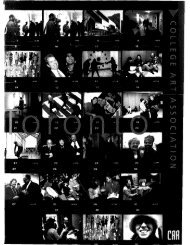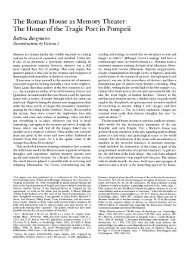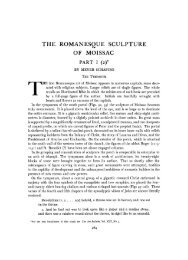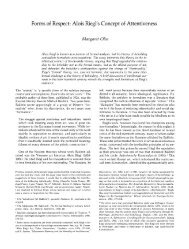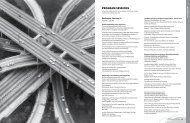THE HUMANISTIC THEORY OF PAINTING - College Art Association
THE HUMANISTIC THEORY OF PAINTING - College Art Association
THE HUMANISTIC THEORY OF PAINTING - College Art Association
You also want an ePaper? Increase the reach of your titles
YUMPU automatically turns print PDFs into web optimized ePapers that Google loves.
UT PICTURA POESIS: <strong>HUMANISTIC</strong> <strong>THE</strong>ORY <strong>OF</strong> <strong>PAINTING</strong> 221<br />
And this doctrine in De Piles anticipates, four years before its translation by Boileau, the<br />
enormous influence that would gather momentum in the following century of the treatise of<br />
Longinus on the Sublime. De Piles was definitely influenced in his later writings by Longinus<br />
who had maintained that the sublime in art is the product of genius-of that inward great-<br />
ness of soul that must from time to time inevitably transcend the rules, the correct observ-<br />
ance of which by a lesser artist would result in mediocrity.?09<br />
Some thirty years later when the Longinian temper had grown upon him, De Piles<br />
again showed his skepticism of prescribed rules for expression when he criticized those defi-<br />
nitions of the passions that Le Brun in his treatise on the subject had taken from Descartes'<br />
Traite' des passions de l'dme. De Piles remarks truthfully and, one may hope, a little<br />
caustically, that these definitions are not always accommodated to the capacities of painters,<br />
who are not all philosophers, though in other respects they may not want sense and good<br />
natural parts."10 He adds that Le Brun's definitions are very learned and fine but too<br />
general, and it is perfectly clear from the pages that follow that De Piles found the ancients<br />
who appealed to nature (he has Horace and Quintilian particularly in mind) more valuable<br />
sources of advice for the painters on this important subject than he found Le Brun, even<br />
though the latter's treatise carried with it the impressive sanction of the Cartesian philoso-<br />
phy. The modern reader of Le Brun's treatise will scarcely fail to agree with the opinion of<br />
De Piles, for nowhere did the aesthetic legislation of the Academy display itself in such<br />
absurdly detailed and absurdly abstract categories as in this attempt to specify the minute<br />
changes in facial expression by which each passion manifests itself through the complex<br />
action of those subtle vapors known as the esprits animaux which are the product of certain<br />
refinements of the circulatory system. One need not consider here the details of those<br />
deformations of pupil, eyebrow, nose, and mouth, or of those changes in complexion wrought<br />
by the esprits after sensory or imaginative stimuli have set them in motion. It should be<br />
remembered, however, that the treatise of Descartes, who shared the profound interest of<br />
his age in the perturbationes animae, was largely responsible for the special psycho-physio-<br />
logical character of the theory of expression during the last decades of the seventeenth<br />
century among the painter-theorists of the Academy who, legislating as they were for an<br />
art that would conserve the outward record of the soul's inner activity, were naturally far<br />
more precise in charting the details of expression than the philosopher himself had been.<br />
But behind the categorical exactitude with which they formulated the visible manifesta-<br />
tions of these invisible states of the soul lay not only the rational thoroughness of the<br />
Cartesian method, but also the central concept of the Cartesian physics that the whole<br />
passage in Plato's Phaedrus (245a): "But he who without<br />
the divine madness comes to the doors of the Muses, con-<br />
fident that he will be a good poet by art (K rxv7ns), meets<br />
with no success, and the poetry of the same man vanishes<br />
into nothingness before that of the madman" (trans. H. N.<br />
Fowler, Loeb Classical Library, London and New York,<br />
1928, p. 469). Junius (De pictura veterum, Amsterdam,<br />
1637, I, 4, p. 22) applies the Platonic concept to painters as<br />
well as poets: "Utraque certe sequitur occulta quaedam<br />
naturae semina: unde persaepe videas cum Poetas, tum<br />
Pictores, ad amorem artis non tam provido multum diuque<br />
pensitatae rationis consilio duci, quam coeco quodam avi-<br />
dae mentis impetu trahi atque impelli." Lomazzo (see<br />
note 75) had already remarked that painters are like poets<br />
in sharing "il furor di Apolline." In insisting on the neces-<br />
sity of inspiration in artistic creation as opposed to reason<br />
(even though the latter also be encouraged to make its con-<br />
tribution), the Platonic tradition of the Renaissance prepared<br />
the way for the enthusiastic reception later of the<br />
doctrine of Longinus.<br />
lo9. See note 311 and p. 262.<br />
Iio. Cours de peinture, pp. 164 ff. It should be noted<br />
that after criticizing Le Brun, De Piles turns about and pays<br />
his respects to the famous Academician, remarking that his<br />
demonstrations may be of service to most painters. But<br />
certainly this is said without conviction and is merely a<br />
lukewarm and perfunctory salute to the tradition with<br />
which in this as in other respects, De Piles was often in<br />
disagreement. Descartes' treatise was published first in<br />
1649. Le Brun's Traite des passions, as he called it in<br />
manuscript, was published first in Amsterdam and Paris<br />
in 1698 under the title Confirence de M. Le Brun ... sur<br />
lexpression ginerale et particuliere. The treatise is reprinted<br />
in Jouin, Charles le Brun, Paris, 1889, pp. 371-93.



